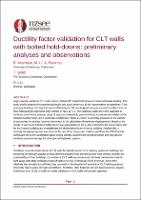Ductility factor validation for CLT walls with bolted hold-downs: preliminary analysis and observations

Download
Date
2022-04-27Authors
Moerman, Ben
Li, Minghao
Liu, Angela
Smith, Tobias
Palermo, Alessandro
Metadata
Show full item recordAbstract
High-capacity cantilever CLT walls can be created with bolted hold-downs to resist earthquake loading. This study briefly presents the experimental results and cyclic behaviour of the representative test specimen. Then prototype buildings of 3 and 6-storeys in Christchurch, NZ are designed using an assumed ductility factor of three following the equivalent static method in NZS 1170.5. The cantilever walls were then subjected to nonlinear time history analyses using 12 spectrum-compatible ground motions to evaluate the validity of the selected ductility factor and a deflection amplification factor kdt which is currently proposed as one method of accounting for pinched hysteretic behaviour in the calculation of maximum displacements. Based on the results, it was found that the ductility factor was appropriate but the kdt factor tended to the conservative side for the 3-storey building and overestimated the deformations in the 6-storey building. Additionally, a severely damaging response was observed for one of the two ground motions used from the 2010 Darfield earthquake due to the acceleration spike at long periods evident in the recorded motion and may present similarly excessive damage for other pinched hysteretic systems.
